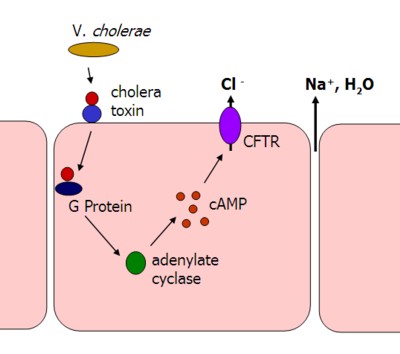
Vibrio cholerae
Cholera is a serious intestinal disease caused by vibrio cholerae.
- epidemiology
- classification and characteristics
- virulence factors
- transmission and infection
- clinical manifestations
- diagnosis
- treatment
Epidemiology
Classification and Characteristics
Virulence Factors
The symptoms of cholera are caused primarily by cholera toxin, the main virulence factor of the bacteria. Cholera toxin consists of two subunits - the enzymatic A subunit and a pore-forming penameric B subunit.
here is a PDB explanation and illustration of cholera toxin

Cholera toxin is released from bacteria in the gut lumen and binds via the B subunit to GM1 receptors on enterocytes, triggering endocytosis. Following activation in the cytosol of an infected cell, the A subunit enzymatically activates a G protein and locks it into its GTP-bound form through an ADP-ribosylation reaction. Cholera toxin can then go on to activate other G proteins.
Constitutive G protein activity leads to activation of adenylyl cyclase and increased cAMP levels. High cAMP levels then go on to activate the membrane-bound CFTR protein, leading to dramatic efflux of chloride, sodium, and water from the intestinal epithelium.
Transmission and Infection
- fecal-oral spread, usually as a result of poor sanitation and water contamination
- V. cholera binds to the wall of the small intestine with pili and produces cholera toxin, resulting in massive water and ion loss in the absence of mucosal damage.
Clinical Manifesations
The incubation peroid of cholera is 1-3 days, and symptoms usually begin with abrupt, painless diarrhea and vomiting. Stool loss may exceed 1L/h in adults but is usually much less. Water and electrolyte depletion leads to thirst, muscle cramps, weakness, sunken eyes, and wrinkling of skin on the fingers. Severe metabolic acidosis with K+ depletion, but normal Na+ serum concentration, occurs.
Diagnosis
Treatment